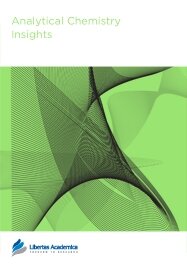

Publication Date: 27 Aug 2008
Journal: Analytical Chemistry Insights

A simple, specific, sensitive, and rapid high performance liquid chromatography (HPLC) method for the determination of griseofulvin in small volumes of rat plasma was developed and validated using warfarin as an internal standard. Biological sample preparation involved simple extraction with acetonitrile, followed by dilution with aqueous mobile phase buffer (20 mM sodium dihydrogen phosphate, pH 3.5) to eliminate any chromatographic solvent effects. Griseofulvin and warfarin were baseline separated and quantitated on a C18 reversed phase column (4.6 × 150 mm, 3.5 µ m), using a mobile phase composed of a 20 mM aqueous solution of sodium dihydrogen phosphate-acetonitrile (55:45, v/v, pH 3.5) delivered at a flow rate of 1.0 mL/min, and with fluorescence detection (λexcitation = 300 nm, λemission = 418 nm). The method was proven to be linear over a plasma griseofulvin concentration range of 10 to 2500 ng/mL with a mean correlation coefficient of 0.9996. The intra-day and inter-day accuracy (relative error) were in the range of 0.89% to 9.26% and 0.71% to 7.68%, respectively. The within-day precision (coefficient of variation) was less than 3.0% and the between-day precision was less than 7.5%. The mean recovery of griseofulvin from rat plasma was found to be 99.2%. The limit of detection (LOD) and the limit of quantification (LOQ) of griseofulvin were determined to be 1 ng/mL and 10 ng/mL, respectively. The developed method was successfully applied to quantitatively assess the pharmacokinetics of griseofulvin in rats following a single 50 mg/kg oral dose of the drug.
PDF (652.03 KB PDF FORMAT)
RIS citation (ENDNOTE, REFERENCE MANAGER, PROCITE, REFWORKS)
BibTex citation (BIBDESK, LATEX)

I have published more than thirty research papers in internationally reputed high impact factor journals including Libertas Academica publications, Proteomics Insights and Analytical Chemistry Insights. I have no hesitation in saying that Proteomics Insights is highly efficient for its rapid and high quality review process and keeping the authors informed at each stage of the publication process. I recommend this journal for students, teachers and research workers who wish to publish their work. ...

All authors are surveyed after their articles are published. Authors are asked to rate their experience in a variety of areas, and their responses help us to monitor our performance. Presented here are their responses in some key areas. No 'poor' or 'very poor' responses were received; these are represented in the 'other' category.See Our Results
Copyright © 2013 Libertas Academica Ltd (except open access articles and accompanying metadata and supplementary files.)
FacebookGoogle+Twitter
PinterestTumblrYouTube